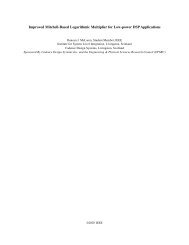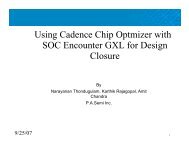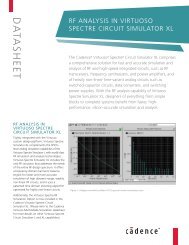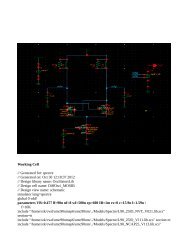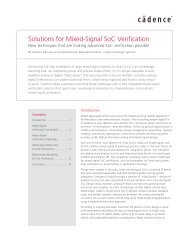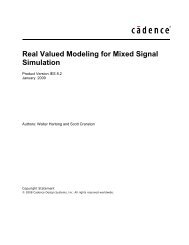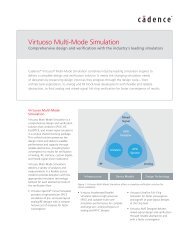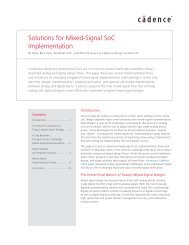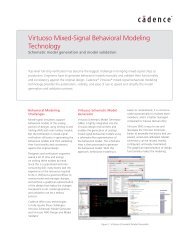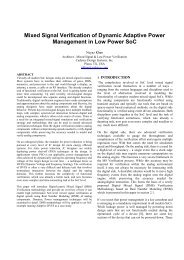Mixed Signal Assertion Based Verification - Cadence Design Systems
Mixed Signal Assertion Based Verification - Cadence Design Systems
Mixed Signal Assertion Based Verification - Cadence Design Systems
You also want an ePaper? Increase the reach of your titles
YUMPU automatically turns print PDFs into web optimized ePapers that Google loves.
ABV with Simvision Simvision: : Go To Cause<br />
Go to Cause finds the assignment<br />
of a signal transition in the waveform<br />
1 Set the time cursor<br />
// GENERIC VERILOGAMS ASSERTION CHECK MACROS:<br />
// This macro prints a message and sets an error flag when the Val is<br />
// too small or too large, and prints an OK message and unsets the error<br />
// flag when it returns to normal operating range. Note that it executes<br />
// Td (seconds) after a crossing event occurs, so that shorter glitches<br />
// will be ignored. First test is performed at time Td. Only difference<br />
// between analog & discrete version is the @() line which defines when<br />
// to repeat the test. Note that the En indicates checking status, not<br />
// operational status, so disabled just means do no checking (error flags<br />
// will stay in "OK" state).<br />
// ARGUMENT LIST:<br />
// Val = input value to check<br />
// Max,Min= validity range of Val. Prints message when out‐of‐range.<br />
// Desc = quoted text for the message ‐ prints as: "{Desc} is too high"<br />
2 Select the signal of choice<br />
3 Use the right mouse button pop-up<br />
menu and select Go to Cause<br />
<strong>Assertion</strong>s Using Behavioral Language<br />
November 12, 2010 <strong>Cadence</strong><br />
Confidential: <strong>Cadence</strong> Internal Use<br />
Only 11<br />
<strong>Mixed</strong>‐signal <strong>Mixed</strong> signal // Name languages = quoted text such for value as Verilog‐A/MS Verilog info ‐ prints A/MS as: "{Name} can = be {Val}" used to create monitoring<br />
// Flg = register or integer to hold state (1=error, 0=OK or not enabled)<br />
models // En = input flag to enable assertion checking: 0 means stop checking.<br />
// Td = time delay between event and check; also analog cross time tol.<br />
// Vtol = crossing voltage tolerance (analog form only)<br />
◦ Requires some level of modeling expertise and understanding of mixed‐signal simulation<br />
semantics `define ACHECK(Val,Max,Min,Desc,Name,Flg,En,Td,Vtol) \<br />
reg Flg=1'b0; \<br />
◦ Generally relies always begin on ‘if \ (expr) $display “msg”’ approach<br />
if (En===1'b0) begin \<br />
Flg



